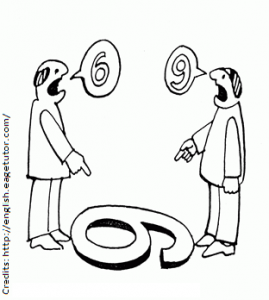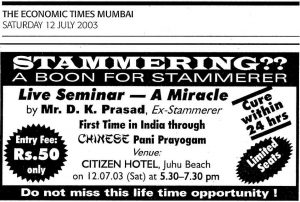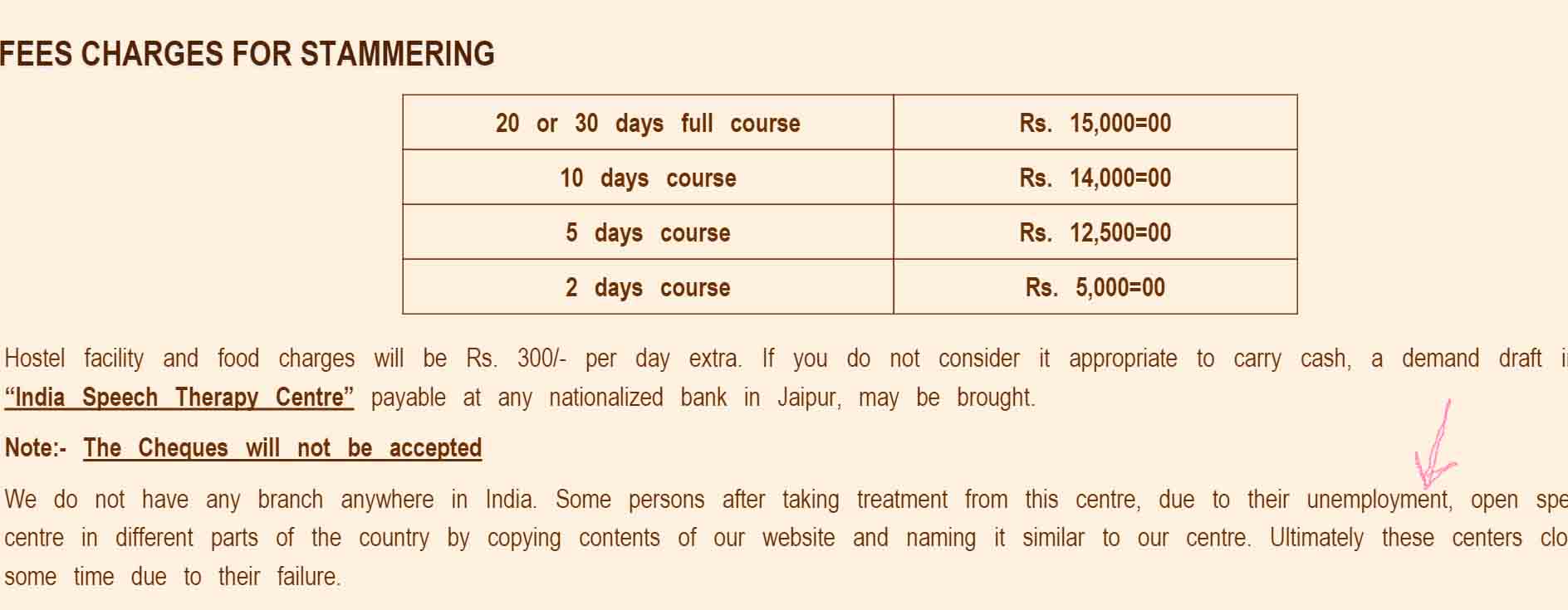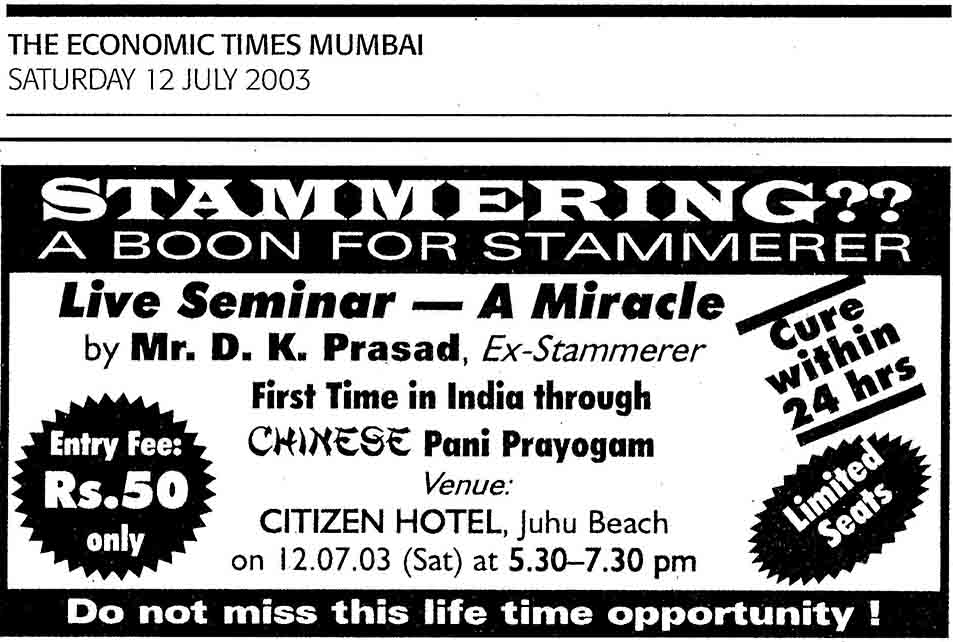Rampant Malpractices
Average pws thinks that “Stammerers are more intelligent than normal people”!
But when it comes to therapy, this superior intelligence is nowhere to be seen. They not only spend over a lac of rupees on a workshop or a gadget, but also go around promoting their questionable choice in a country, where a family of three could happily survive on the same amount for a year. This intelligence again is not in sight, when they have a relapse after a few months: Instead of questioning therapy model or therapist competence, they end up saying: “Sir XYZ was really very good. But I failed to practice what he taught me.. etc.” Then, there are some who are convinced that they benefitted by blowing a conch shell or by loud repetition of a certain mantra- and want to teach that to TISA community! Following examples of malpractices are a living TRIBUTE to our higher intelligence! And the story goes on..
Under Nine Minutes!
Below, cure your stammering under 9 minutes! And they are still in business!
Customised packages
See below, someone is offering you customised packages for a suitable fee: 30 days, 20, 10, 5 and even 2 days. And if you are still stammering then, either you are very lazy or very poor! You decide.
PRIVACY!
Surely you dont want to go out of your home, seeking help – because Gupta uncle in the neighborhood, will ask you all about it. So, privacy is you big need- more than even Fluency! Well, you dont have to leave your home or talk to strangers at all- just lean back in the privacy of your bedroom (lock the door) and watch this DVD:
Crash in and Out!
Some more examples of our superior analytical prowess. How many types of stammering do you know? Don’t worry. Let there be a hundred types. Here is a One Window service for ALL kind of stammering- to be removed in two weeks. And if you or your child is still stammering, you who is to be blamed!
Taz Mahal
And finally here is the Taz Mahal, a monument dedicated to our superior intelligence! Since 2003, it is proclaimimg to educated, English speaking, progressive society of Mumbai and rest of India, that Indian pws are such cerebral intellectuals and live in such rarefied sky of self-serving truths, that they can be sold plain water (not even coffee or beer) for Rs 50 in large throngs… Appropriately enough, it appears in Economic times, because it must have given an upswing to Mr Prasad’s domestic economy in a mere one hour. And since he is a ex-stammerer (- he claims to-), who are we to object. May be we should be happy for him? Because money has remained with in the family, the community of stammerers? (PS: Not even our Nationalism revolted at Chinese water? ha ha..)
A little laugh at ourselves is OK. Let us do that and learn from our follies and move on.
If old clients do not talk about it, who will?
Our Approach
Our approach has evolved over many years of failed therapy sessions and well meaning advice – “Go for it again; Therapy has improved a lot !”. We have also witnessed a sense of entitlement and self-righteousness among the profession bent upon helping us, no matter what. Therefore ideas like self-help, stammering as a diversity are scoffed at by the professionals. Thanks to such reactions and attitudes, we have evolved certain principles which inform our work, as given below.
Guiding Principles
Participation on equal footing: There is little hierarchy. We all are peer counselors. The groups may have functional roles like Coordinator, but these are rotated.
Experiential Learning: We accept a new idea (eg. “stammering is no big deal”) only when we have experienced it in ourselves, ie. by doing a stammering interview with a stranger. So practice is valued more than concepts.
Communication: We value the functional aspect of speaking more than the aesthetic aspect, ie. fluency. Character is more important than looks. End of the day, getting the meaning across is vital.
Community: Social connections and a self-regulated community based on a wholesome ideal, is the cornerstone of our approach.
New Frontiers: If looking at stammering as a diversity, and educating society towards that end, can make life easy for children and adults who stammer- as well as for therapists too, why should we not look at that bold idea? We dont want to throw away any idea just because it is not covered under latest journal of Communication Disorders.
Ethos of the land: Selfless service to others is the highest form of worship. One pws coaching another pws, therefore should never become subject of market forces or of self-promotion. Wisdom of the land also proclaims that the source of all perfection is within.
Tools & Techniques?
Relying on ourselves and on our groups is not easy and flies in the face of worldly wisdom. Some will shake their heads ominously and say: What? Blind leading the blind? But the group dynamics, under good facilitation can transform the “speaking” experience for a pws. It has been said that science is crystallized common-sense. This applies to speech science too. All techniques and tools have emerged by observing stammering. So, all the tool that we promote in TISA intend to do that- transform the stammering moment, not eliminate it: if I am going to repeat a word in a stammering spell, let me do it with more consciousness and control, ie. I will bounce couple of times, or prolong, with good eye contact – and carry on. If nothing works and I am going to stammer- let me do it happily & consciously (=Voluntary stammering). To this extent, we talk about tools or techniques. But always with a focus on the job to be done: communicating something. That something is more important than techniques or fluency. We also totally accepts someone who may not want to use any tool or technique. He or she may communicate through SILENCE, mime or text. It is their RIGHT. (See this and heading “6. Communication” in this post to understand why focus on communication can be so important).
Pausing
Pausing has been promoted as a TECHNIQUE- but the fact is, it is a very natural part of every-day communication. We say something- then we stop to listen to the other person. Sometime we stop, to catch our breath (talking takes effort, right?), to think ahead, to read the other person’s face (Has he understood or not? Does he agree?) – and sometime we pause just for the sake of silence, because in “special” company and on special “occasions”, silence is all that is needed, silence is more eloquent than words at those times. So, why do pws find it so difficult to have these natural and useful pauses in their speech? For many pws, childhood experiences convince them that talking is a difficult/ risky task and therefore should be finished as soon as possible! They may also, erroneously, believe that if they stop, restarting will be difficult! Driven by such psychological pressures and distortions, they may speak fast or non-stop, without listening to or letting the other person say anything. Naturally we don’t create a very pleasant impression on the other person and she or he may not want to talk to us again! Please look at the attached video (only 3 minutes) of Eckhart Tolle and see he uses pauses in a very natural and relaxed way (Screen shows “Pause”). https://youtu.be/gvlX7bmPsow What is he doing in those pauses? When you replay it a few times you will discover that he is using even pauses to say something, to add something. THAT is communication – as opposed to fluency which we often chase and so many are selling to us.
Now, please don’t think that this style of slow talking is something which cannot or must not be changed. In the second video, same Eckhart is being interviewed by Oprah and obviously the pace here is fast. https://youtu.be/-0hxYtkNOaw?t=1h12m41s Even in this second video, please note that Eckhart listens very attentively and quietly to Oprah, here and there, especially at the beginning of the video! Soon the interview is well underway and both of them are talking faster. But the communication is still intact. He is able to speed up, slow down, rephrase, stop and listen, smile, gesture, come up with examples… He is able to do all this because he is talking about a topic which he has lived, day and night. Secondly, he is not looking intimidated by the studio or the Oprah. He is not trying to IMPRESS anyone. He is being natural – and therefore, he comes across as a good teacher and communicator.
Bouncing
This is where we bounce like a rubber ball, a few times, in a relaxed way, before saying the rest of the word. Bouncing is done on the initial sound in a relaxed way, with enough gap between the two bounces, with good eye contact and preferably with a smile too. Always begin with easy words, easy situations and easy audience. Gradually increase the level of difficulties and the words. Best place to begin is your self help group- physical or online. Record yourself and review. The following video (Hindi) explains the techniques. Watch the video below, up to about 19 minutes to understand Bouncing.
Prolongation
Prolongation or Stretching or Lengthening: This is where we stretch the vowel sounds (a,e,i,o,u) not the consonants (K, B, P etc.). Watch the video below (HMPS2) from 19 minutes onwards.
Voluntary Stammering
VS is a popular desensitization technique, adopted from Psychology. It helps you to get over the intense but insidious emotional reaction following stammering. It simply means, to create an intention of letting yourself stammer WILLINGLY, with good eye contact and a happy and curious frame of mind (Let me see how it feels and what follows!). Because of habitual suppression of stammering, you may not succeed the first time. But keep trying and laugh after every attempt. Record it and review it. When you are able to reproduce your own special stammer, with all its secondary behaviours and emotions- try to stop it in the middle for a second, to study it “from inside”. Where is your tongue, jaw, gaze? What are your hands doing? Which part of body feels abnormal and tense? Then, let it go:
My name is Kkkkkkkkkk—(stop & observe)— kkamal.
This kind of Kinesthetic awareness will help you to gradually transform your blocks to near-normal fluent speech. VS is the first step to learn block corrections. More details in mooc. It is also the BEST approach to emotional recovery, when done with strangers – or in Metro, like our Delhi group!
Common Mistakes
There are no ONE PERFECT technique. You should ideally try your hand at all the four and become proficient at all the four. In fact these techniques have an underlying synergy: if you can try a little pausing successfully, it means your speech system, which is highly autonomous and habit based, has opened up to a little change. Gradually, over the months, it will change so much that it will not look at all like your old stammering.
PWS often make the mistake of giving up at the first difficulty or a chance comment: My family says – your new technique sounds weird. Your old stammering was OK..
It is critical that you move from easy words, easy situations and easy audience to more difficult ones in a systematic and GRADUAL process. Some pws jumpstart by bouncing on “good morning” with their boss on the first day! Result is not what they expect and then, they withdraw in their shell of denial and lethargy.
When you are drowning, that is not the time to learn swimming- or anything! Some pws want to learn techniques just on the eve of important Visa interview. Instead, we request you to start early and commit a long period (as if you were learning a foreign language) – one year or more.
Again, practicing these or any technique in the privacy of your home is no good- unless you stammer at home alone! Any practice which does not challenge you at gut level, probably will do you no good. So, raise the level of challenge every few days. Your self help group is a good place for inventing and practicing new challenges.
Also, if you are deeply in love with Fluency and CURE, every little setback will thrust you in depression. You will give up soon. It is important to set a realistic, holistic and practical target. These goals are not such worthy goals:
कल लड़की वाले आ रहे हैं.. उनके सामने मै ठीक से बोल पाऊं /
मेरा भाई तो कोई प्रैक्टिस नहीं करता, वह तो सीधे बोलता है, मुझे क्यों करना पड़ रहा है ये सब../
My GF makes a funny face when ever I stammer. I want to stop stammering..
Just teach me how to say my name. Rest I will manage.
I want prove to that bully (or my class, or GF, or Boss) that I can speak well..
A better goal would be like- I dont want to struggle so much when I talk. I want to learn to deal with my blocks so that I can focus on my content. I want people to understand me when I speak, without so much struggle etc.
Finally, all this comes easy, when you are not fighting yourself day in and day out; In stead, you have accepted yourself and calmly proceed to change old habits of thinking, feeling and acting.
Power of one plus one
Comm WS March 2015
Principles in Action
Social issue, Social solutions?
If stammering is a social issue (we dont stammer when alone)- the answer had to be found in SOCIAL settings – not in CLINICAL settings. We have closely observed many stammerers, in a large gathering – like our conferences; They are stammering, they are using no technique and STILL they are so HAPPY and seem so fulfilled! In fact, they appear to become someone totally different! What has changed? They just met a group, which accepted them as they ARE, not as they would be after one year, using this or that technique, gadget or “course”.
How does SHG work?
This alchemy works only in a group of people who share deep life experiences and are walking on the same journey. Of course, power of group therapy has been well known (link). But group therapy usually is led by a therapist. We did not wish to follow that path. Because “therapy” and all its under pinning, only strengthens the popular notion: something is wrong with you which only “expert” can fix. We were fed up of that line!
Taking the responsibility
Turning to the wisdom of this land, we discovered that we suffer whenever we under-estimate ourselves. Ocean is in the drop. Wholeness and healing is inside us – not outside in some test-tube, petri dish or “technique”. The acceptance of who we are at THIS moment, awareness of the power within – all this and more, can unfold in RIGHT atmosphere, at the right moment. But you must take the first step. You must own the process of your recovery. You must invest into it- time, energy and commitment.
Have you suffered enough?
This question is important. Because till you have suffered enough, you will not engage with your own recovery sincerely. You will read pdfs, browse websites, watch inspirational videos, share them in the group – but not take the one step which challenges your fear and your assumptions. Ask this question to yourself, if nothing has helped you so far.
You can water a plant, but flowering happens only when it is ready. Till then, it needs nurture, caring and empathy. This is what our self help groups are meant to be. It is all about innate courage and taking responsibility for our own development. This naturally happens when you have suffered enough.
This Self is not to be attained by the weak… (Mundak Upanishad. III. ii. 4)
Who needs Therapy?
Modern medicine has often rightly been criticized for chopping the elephant in to pieces, in order to study it, understand it. Also, it has narrowed down into super-specialized fields, forgetting about the broader context and the role of environment. No wonder that therapists have kept on trying to fix the stammerer despite relapses, rather than address her/his context, or environment. It is the society which needs “therapy” in our humble opinion! Stammering should be seen as a diversity. Not a disorder. Otherwise scams will continue as of now ( scam ).
Systems Approach
Instead of focusing on the problems of ONE individual (huge as they may be), we are looking for a “system wide” solution; an approach which could help the entire community of people who stammer : This is the characteristic approach of Social Medicine- as opposed to a typical one to one doctor client scenario. Listening to many IPWS, we became aware that stammering was a social issue, which was medicalized (and “problematized”) by healthcare industry. In remote villages, stammering and many other disabilities (or diversity) are accepted as a matter of fact, in day to day life. Why? Because “the expert” has not arrived on the scene, yet.
The New Therapy
So, if we want to move ahead, stammering has to be placed in a social context and seen in a functional (not aesthetics) framework. Primary purpose of speech is not to please others – but to get some job done. This is the arena of social sciences and psychology: groups, role plays, whatsapp, get-together, coaching, journal writing, Google hangout, taking out a rally, going to schools, spreading awareness etc. are going to be our tools of choice.
All this can change the victim mindset: I am a victim of circumstances beyond my control. I must wait for someone to rescue me. Instead, we can connect with others, make a bonfire of our crutches and dance around it! This is what we do through free communication workshops, get togethers, online coaching and peer counseling etc.
But Why Free?
Nothing is free in the truest sense. People attending TISA events or workshops, spend lot of their time and resources. Registration fee often covers their board and lodge. Accounts are shared on line. No one in TISA gets paid or becomes rich! All of us are volunteers. We do respect and value money but also feel that offering selfless friendship to another human being is the best gift one can give to another – and is probably our strongest feature.
Why put a monetary value on this GIFT? Also, in this land, the highest knowledge – Self-realization, Yoga – was always given freely. In present times too, there are modern saints who are happily offering their GIFT for free under open source movement. In any case, self-help for stammering does not involve open heart surgery or Chemotherapy for six month! The way TISA does it, it is very simple: like a little fine tuning of a robust engine! So, why not free? Read more on this theme of how TISA’s work and approach is different from others: ISAD paper on Indian self-help experience.
Communication is the big deal
At the end of the day, what matters is: did the listener understand? or not? THAT is an equal and mutual responsibility. Listener too should pay attention and ask questions. Speaker too, should focus on communication rather than worry about fluency. The communication is a two-way street and both parties are EQUALLY responsible for it’s success- not the stammerer alone. Communication is both the path and the destination of our day to day discourse. This is why, we emphasize listening, eye contact, smile and a lot of other skills instead of “how to talk better?”.
This Self is to be achieved through self-effort...
Gita; Ch 6, Verse 5
Communication : the crux

Transfluency
Dr Cristóbal Loriente made a ground breaking contribution by giving a new conceptual framework to view our problems: Transfluency (ISAD paper, JSTAR paper). Stammering is a different way of talking which transcends notions of Fluency and Disfluency – hence TRANS fluency. These limiting notions have been promoted by a socio-cultural norm, and a medical profession which could think of speech only in dichotomous terms: Fluent or Disfleunt.
He makes this claim based on two main observations: If stammering was really a medical disorder, speech therapy would have had BETTER success at treating it. Secondly: in last two centuries, with the rise of “Modern” medicine, many harmless / natural conditions were medicalised – like left handedness, sexual orientation etc. Essentially he is saying: Stop treating it; Think of it as a diversity; Accept people who stammer; let them also accept themselves and be OK – in a self help group.








